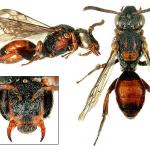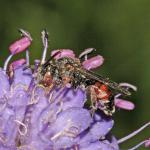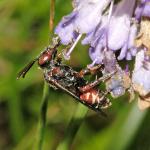Nomada atrata SMITH 1846; Nomada brevicornis SCHMIEDEKNECHT 1882
A rare species found mainly in the more southern counties. Although there are records of the host species Andrena marginata, from south Wales and central Scotland, the Nomada has not been found in these regions. In the past it was recorded from Carlow and Leix in southern Ireland and in 1999 it was found in West Galway. It is usually considerably scarcer than the host bee and, in common with other Nomada species, is not found in all the host's known sites.
In Europe it is widespread, occurring as far north as southern Finland.
Provisionally listed as rare (pRDB3) by Falk (1991).
To be expected where the host bee occurs, i.e. generally on calcareous grassland, coastal dunes, heaths, moors and in woodland.
Univoltine: mid July to mid September.
A cleptoparasite on the mining bee Andrena marginata (Perkins 1919).
Mainly observed on the flowers of devil's-bit scabious and small scabious, occasionallyt on field scabious. The bee has also been swept from red bartsia flowers (G M Spooner, pers. comm.).
None known.
2001




